![]()
![]()
![]()
Use LEFT and RIGHT arrow keys to navigate between flashcards;
Use UP and DOWN arrow keys to flip the card;
H to show hint;
A reads text to speech;
27 Cards in this Set
- Front
- Back
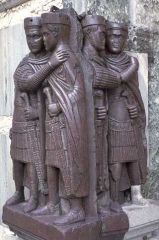
|
Tetrarchs, c. A.D. 305, porphyry LATE IMPERIAL PERIOD, ROME
• Porphyry is the stone associated with the emperors because of its purple color (means you are looking at an emperor • Attached to the church of St. Marks in Venice • Style o Clearly not classical Roman or Greek in terms of natural proportions o Beards represent age—the Elder has the beard (instituted by an emperor named Diocletian who invited another man to be emperor with him to oversee the empire, then the empire was divided administratively; Diocletian also reforms the economy) o Identical faces; same shape eyes and features, same height, no feature individualizes the emperors o Intent of the artist was probably intended to make the styles; CONCORDIA or harmony is the main emphasis of the piece—also depicted by the arms resting on the shoulders • By de-emphasizing certain individualistic elements, this Concordia message is more powerfully depicted |
|
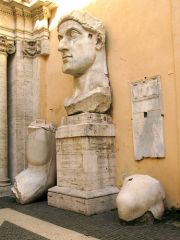
|
Acrolithic Statue of Constantine, A.D. 313 LATE IMPERIAL PERIOD, ROME
• Located in the middle • Bare-chested which would associate him with deity • Rather large eyes; somewhat abstract rendition of the face • Whole composition is to create the idea that he is a god o Interesting because he was the first emperor to accept Christianity after seeing a vision of “Chi-roe”; wins a battle and supports Christianity after the victory • Eusebius, Life of Constantine Book 1 Chapters 25, 27, 28, 31, 37, 38; Book 4, Chapters 58-60 http://www.fordham.edu/halsall/basis/vita-constantine.html |
|
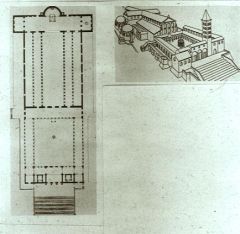
|

Old St. Peter’s, Rome, c. 330 - atrium, nave, aisles, transept, apse, clerestory LATE ANTIQUE/ EARLY CHRISTIAN PERIOD
• Constantine decides to dedicate a church to Peter; Peter’s tomb is located in the center of the dome o Atrium is a courtyard o Nave: center area o Transept: 90 degrees to the nave o Apse: marks the tomb of Peter • Marterium; not a traditional church for worship but was created to memorialize St. Peter • Acted as a covered graveyard of those who wanted to be buried close to a saint; cult of saint develops in that people believe that they need an association in heaven to get INTO heaven |
|
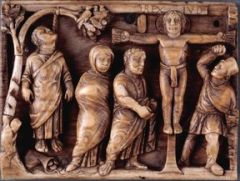
|
Suicide of Judas and Crucifixion, Ivory plaque, c. 420 LATE ANTIQUE/EARLY CHRISTIAN PERIOD
• Etched in ivory • Christ on the cross symbolizes his human nature • Christ’s eyes are still open which signifies he is still alive; not apparently physically suffering since there is no blood or emotion o Juxtaposed with Judas hanging himself o Contrast between good death and evil death • Figures are stubby forms but the poses are in actions that are natural • A variety of different styles are being accepted in this century |
|
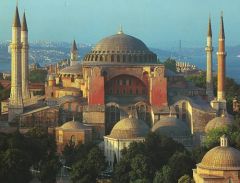
|
Hagia Sophia, Constantinople (Istanbul), 532-537, Architects: Anthemius and Isidore BYZANTINE PERIOD
• Cathedral: comes from “Cathedra” which is a bishop’s throne; only one church of a city is established for major gathering purposes • Dome is directly in the center of the cathedral • Building is as wide as it is long; distinct for churches in the Eastern Christian area • Takes the idea of a basilica that is combined with the domed portion • A normal basilica is architecturally designed so your eye follows the colonnade; this is designed in a way that forces your eyes up to the dome • Style of the dome o Pendentive—makes the transition from a square to a circle—Spherical Triangle—which creates a support for the dome in the corners o Dome functions the same way an arch does (daring design) which is supported by a buttressed support system on the outside |
|
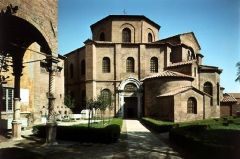
|

San Vitale, Ravenna, 526-547 - Justinian and Theodora BYZANTINE PERIOD
• Church was built on the site where the Saint was believed to have been martyred • Body of the church is in an octagon (8 is the number for rebirth) • Inside is where another octagon is surrounded by a colonnade; limiting view for a congregation which is one major drawback of the design • Very plain outside decoration • Mosaics: o Christ in the archway • On the mosaic, Christ is still dressed in the imperial color of purple signifying he is emperor of the universe • All churches are dedicated to Christ even though they may be officially dedicated to a saint • The panel of Justinian is on the right hand of Christ….. o Empress • Halo symbolizes that she is an empress and the architecture frames her • Holding a chalice which represents her bringing a gift to the church, seen with the magi who are also offering the gifts • The men are seen with senator’s clothing • Figures are in frontal poses • Head is small on very elongated bodies • Only hints of shadows on the faces; non existent on the clothing o Justinian • Justinian is seen in the center (emphasizing his importance) holding a paten or his gift • People standing next to him are all behind him, as if he is leading the procession • The priest on the right hand side is “coming out of the border” • All are in a frontal pose with same proportions; limited modeling, and abstract style • There is a priest who has had obvious changes to his face and the inscription; suggests a new bishop at the time • He has a smaller head than the rest of the group |
|
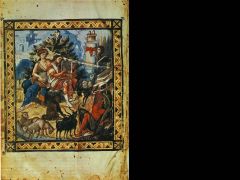
|
David the Psalmist, Paris Psalter, c. 960 BYZANTINE ART
• Done in a classical-looking style • Frame is created and acts as a window • Center is David who is the composer; in a ¾ pose with light highlights in terms of shadowing and lighting o The woman is a personification of melody and his muse o The man in the corner is a personification of a topographical personification of where David wrote this Psalm o The woman behind the pillar is Echo • Shows that artists are able to do classical work—when they want to be o Revival in the style of personification of either elements or topographical elements |
|
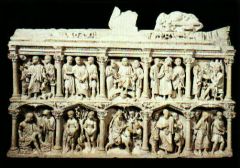
|
Sarcophagus of Junius Bassus, ca. 359 LATE ANTIQUE/ EARLY CHRISTIAN PERIOD
• Was the mayor of the city of Rome, was newly baptized • Style o Divided into two registrars, then into scenes o Figures are carved in very high relief which makes them stand out o Has a program where the scenes play off of each other • In the middle top, Christ is depicted without a beard (normal for early Christian art) and is handing the law/ authority to the apostles Peter and Paul before he ascends into heaven • Christ’s foot is resting on Caelus’ head (Roman god of the sky) which is being used as a symbol of the sky; sky is his footstool • Entry into Jerusalem is just below where Christ is proclaimed as King of the Jews • Story of Abraham in the far top left; prototype of Christ being sacrificed • Crucifixion was rarely depicted in early Christian art; afraid that outsiders might view Christ as a criminal based on the type of death he underwent • Nudity represented sin, or innocence • Figures are in contraposto and in natural proportions and movements, classical influences |
|
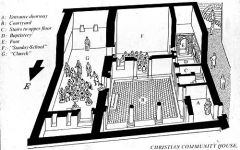
|
Baptistery, Christian House, Dura-Europos, c. 240 LATE ANTIQUE/ EARLY CHRISTIAN PERIOD
• Barreled vault arch over baptismal font; actually adapted from catacombs which is symbolic as someone who lays down into the water and then reborn as a follower of Christ • Art in baptistery is that of Easter Morning when Christ is resurrected o Baptisms were only performed on one day—Easter Morning • Sophisticated thought put into the scenes of art and layout of the church • Crude styles of art and techniques; sophisticated in its theology behind the art |
|
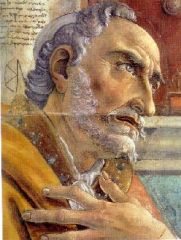
|
Augustine, The City of God
http://www.utm.edu/research/iep/a/augustin.htm LATE ANTIQUE/ EARLY CHRISTIAN PERIOD • Has training in classical philosophy • What happens in the world is mostly a fight between good and evil • The main purpose of life was to seek after truth—something adapted by Plato but he believed it • Converted to Christianity; his most important work is “The City of God” o Written in response to the Fall of Rome and the Paegans who claimed that too many people became Christian which was the ultimate fall of the Roman Empire o Takes Platonic philosophy and combines it with Christian theology • First writer that Christianizes Plato’s philosophies • One city is that of unbelief, selfishness, and physical appetite lead to damnation • In the city of God; one that is guided by faith, the spirit, the love of god instead of self => leads to happiness |
|
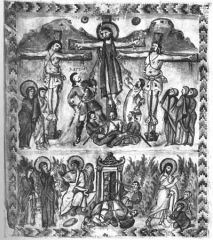
|
Crucifixion and Resurrection, Ascension, Rabbula Gospels, 586
BYZANTINE ART • On the top is Mary, Christ, and the two thieves—Longinus • Don’t see the crucifixion scenes very much—but don’t seeing him suffer • NARRATIVE ART that is set in a landscape which gives atmospheric perspective, illusionistic style—trying to indicate space o Down below the soldiers are gambling for his clothing • In Byzantine Art, Christ is always seen wearing a tunic • Below, the tomb of Christ is seen where the women are waiting for Christ but then He greets then in the garden (CONTINUOUS NARRATIVE that has no border to divide the scenes) |
|
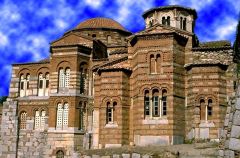
|
Monastery of Hosios Loukas, Phocis, Greece, BYZANTINE PERIOD
• OUTSIDE o Acted as a great social release point; those who were unable to support themselves found refuge acting as a monk • Imitating John the Baptist who went and lived away from the cities and focused on a life of prayer (Monasticism) o The dome is a symbol of heaven so it is still employed in architecture o In the smaller dome, there are nine compartments which creates a cross which creates a “Cross-in-square” o Tripartite sanctuary on the east—main apse with flanking aspes o The dogtooth freeze is the style of the outside bricklaying which is a more unique style of laying brick, not necessary for structure o The catholicon is the main dome which is larger and rests on a series of piers • INSIDE o The sanctuary is screened off o Trying to de-emphasize the structure by creating sectioned off corridors instead of a long hall where the service could be viewed o On the top of the dome would have been an image of Christ o Mary is in the second most important figure of heaven so she is in the secondary-important architecture location • Divided into zones of Celestial, Telestial, and Terrestrial |
|
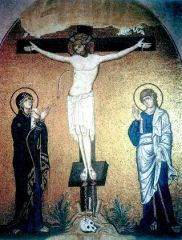
|
Crucifixion, Church of the Dormition, Daphni, Greece, ca. 1100, BYZANTINE PERIOD
• All of the key figures are left out • Christ himself, compared to earlier depictions of this scene, is shown suffering o His head is tilted and his eyes are closed, his wounds are bleeding o Not narrative art which tries to depict a scene completely • Artist now FOCUSES ON THE MESSAGE OF THE SCENE, NOT NARRATING IT • Mary is pointing to Christ which suggests to the viewer to look at Christ ; she stands as a witness of his suffering • John is tilting his head towards Christ which is suggesting to take the focus off of him • The mound is representative of Calvary or Golgotha with the skull of Adam at Christ’s feet o Eludes to the fact that Christ’s sacrifice is for Adam and his posterity • USE o On Good Friday, the Monks would gather around and hold a service near this mosaic and also become “witnesses” of His Crucifixion • STYLE o Proportions are slightly stretched o HARSH modeling on the figures; shadowing that is not gradual |
|
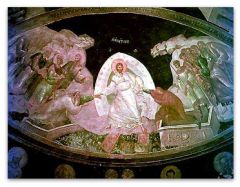
|
Harrowing of Hell (Anastasis), Kariye Camii, Istanbul, c. 1320 BYZANTINE PERIOD
• long hall-like chapel • In the apse, there is a different image of Christ of Him visiting the spirit prison (Hell where he has broken down the gates) o He is wearing white cause he is in a different physical state o The Almond-shaped mendola…. o Seen pulling Adam (with the right hand) and Eve (with his left hand) out of the earthly tombs which represents the first steps of the resurrection • STYLE o There are a lot of white highlights which help model 3-dimensional mass about them |
|
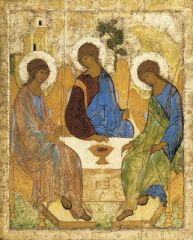
|
Harrowing of Hell (Anastasis), Kariye Camii, Istanbul, c. 1320 RUSSIAN ART
• long hall-like chapel • In the apse, there is a different image of Christ of Him visiting the spirit prison (Hell where he has broken down the gates) o He is wearing white cause he is in a different physical state o The Almond-shaped mendola…. o Seen pulling Adam (with the right hand) and Eve (with his left hand) out of the earthly tombs which represents the first steps of the resurrection • STYLE o There are a lot of white highlights which help model 3-dimensional mass about them |
|
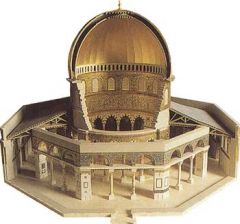
|
Dome of the Rock, Jerusalem, 687-692 ISLAMIC ART
• Octagonal plan with a dome within a central colonnade • OUTSIDE o The point of the building is to mark a site that is considered sacred which is borrowed from the Christians • INSIDE o Dome covers an area of exposed rock • Remains of the altar of where Abraham was about to sacrifice Ishmael • This is where Mohammed began his night journey where he was taken by Allah • Third most important Islamic site o Within the dome, there is a great amount of decoration but there are NO IMAGES of people or animals |
|
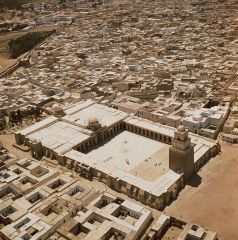
|
Great Mosque, Kairouan, Tunisia, 836-875 ISLAMIC ART
• A mosque is where weekly traditions are held • Rectangular layout which symbolically says that it is a protective place where god is worshipped • The tower on one end was for a cleric to call for prayer • Within the prayer hall, there are rows of columns that employ Corinthian columns with a small niche (mirab) that shows where west (Mecca) is located |
|

|
Mosque of Selim II, Edirne, Turkey, 1568-75 Architect: Sinan ISLAMIC ART
• Obvious idea of architecture taken from the Hagia Sophia o Similarities • Windows at the base of the dome o Differences • 8 piers about the dome instead of just 4 • Obviously the architect is trying to fix the errors of Hagia Sophia o Inside • Large use of space • Minbar in the middle of the room at the top of the stairway is where the person that leads the service/prayer stands • Relates to the chair that Mohammed • Use of geometric and organic designs, decorations everywhere |
|
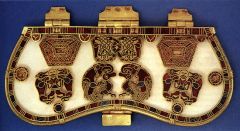
|
Purse Cover, Sutton Hoo Ship Burial, c. 655 - cloisonné ART OF THE MIGRATION PERIOD
• Site located in South Eastern England where a ship burial occurred; a pit was dug for the king’s body and a ship was laid in the ground with him • This fittings for a leather purse was found in the excavations o Done in gold using a technique “cloisonné” where the chambers are created and then stones are cut to fit the chambers o Millefliori—a thousand flowers—was the technique that created the checkerboards • Served as decorative and utilitarian purposes ALSO has intrinsic values • Interlacing designs of creating figures; some mystical wolves in the top center, eagle-like bird attacking ducsk, and the man being attacked by a stylized and indistinguishable figure—NO USES OF CLASSICAL ART TECHNIQUES |
|
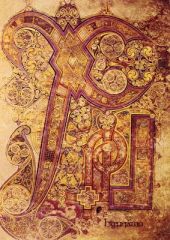
|
Chi-Rho Page, Book of Kells, c. 800 ART OF THE MIGRATION PERIOD
• Has the most amount of decoration than any other manuscript of its kind • This page begins the text of Matthew • Ribbon interlace, animal interlace • Spirals which are also found in metalwork • Busy and complicated from a distant, detailed up close • No real significance for the animals and angels inset into the design o No perspective or proportions |
|
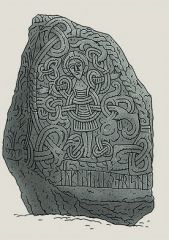
|
Royal Rune Stones, Jelling, Denmark, 960-85 VIKING ART
• Story of the crucifixion of Christ is being symbolized but MIXED with local art traditions • Strong outlines that cut out the facial features, folds of the clothing are going horizontal, not natural vertical • Only the subject matter is the aspect that is affected the most by Roman Christianity |
|
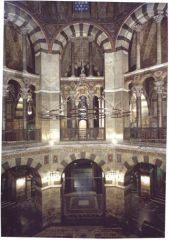
|
Palatine Chapel, Aachen, 792-805, Architect: Odo of Metz CAROLINGIAN ART
• Only thing that remains of Charlemagne’s Palace • Reminiscent of the Church of San Vitale with the 8 piers on the inside of the dome o Pretty clear that Odo of Metz and Charlemagne wanted S. Vitale to be the example by which this chapel was to be designed • Up in the gallery level is where the throne was located o 6 steps on the throne; exactly what Solomon’s throne had • Dome is referencing to the Second Coming; Christ is suggesting that Charlemagne was chosen to rule o CHARLEMAGNE IS NOT FOLLOWING TRADITIONAL FRANK |
|

|
St. Matthew, Coronation Gospels, c. 800-810 CAROLINGIAN ART
• Done in a contemporary style • These gospels were found in Charlemagne’s tomb, it was then removed and used in the coronation ceremonies for later emperors • Only four illustrations • STYLE o Page was dyed a purple color o Text is in gold writing o Artist has framed the image with a border to create a “window” into a 3-dimensional scene o Matthew is in a ¾ pose and because of the modeling it looks 3-D • An inscription in the back of the gospels indicates that Demetrius was a scribe; he was of Byzantine art so he must’ve come west and have been the artist too o Techniques found in Byzantine art manuscripts |
|

|
Plan of St. Gall, c. 819 cloister, refectory CAROLINGIAN ART
• An ideal monastery plan, rare because no other architectural drawing survived from this period • An apse of the west end was done in memory of St. Peter’s • The boxes seen with crosses are altars • Cloister was the addition of a courtyard • The long rectangles were beds in a dormitory to increase accessibility to monks • Refectory was the dining hall which was on the opposite side of the cloister o A pulpit was located in the refectory so a brethren could’ve spoken during meals o A winery was on the south end of the cloister o A scriptorium near the church was where manuscripts were created • A hospice was located near the Monastery in addition to animal pens etc |
|
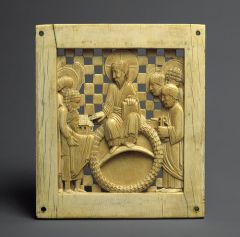
|
Otto I Presenting the Magdeburg Cathedral to Christ, ivory, c. 962-68 OTTONIAN ART
• Christ is in the middle sitting on an arched wreath which represents the universe • Otto is holding a model of a church and presenting it to Christ; He accepts it by touching it o Otto is in a smaller proportion compared to everyone else • Symbolic of the leadership of this Western Empire (Hierarchy of scale) • Dedicatory scene which represents the person’s piety in the creation of the church |
|
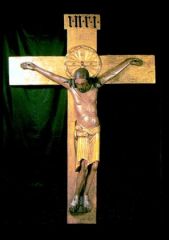
|
Crucifix of Gero, c. 970 OTTONIAN ART
• Christ is shown either dead or close to death • It is now acceptable to show Christ suffering; now considered a reliquary which emphasizes its importance • Weight of the body is shown pulling at the nails, chin is on the chest and the eyes are closed • Iconography has evolved from showing a “pleasant” death to a more accurately depicted scene • Would originally be placed behind the altar • Indication of rebirth of Sculpture in the middle ages |
|
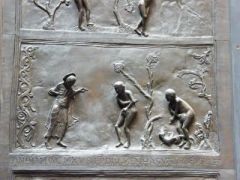
|
Bronze Doors at St. Michael, Hildesheim, 1015 OTTONIAN ART
• 15 feet tall • One large solid bronze panel that was cast together • This was something that was not seen since the Roman period • The scenes are of Old and New Testament Stories o On the left side, the story board runs from the top to bottom; right side, the story board runs from bottom to top o Each panel is parallel to the one it is next to in terms of its story, symbolism, and message • The lord is shown accusing Adam who is then pointing to Eve who is pointing the blame to the serpent o Adam is not looking at the lord because he is ashamed • No definition of physiology |

